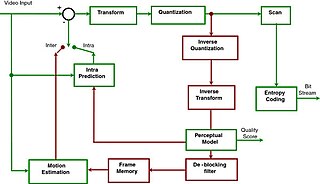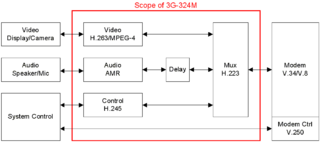Related Research Articles

The Moving Picture Experts Group (MPEG) is an alliance of working groups established jointly by ISO and IEC that sets standards for media coding, including compression coding of audio, video, graphics, and genomic data; and transmission and file formats for various applications. Together with JPEG, MPEG is organized under ISO/IEC JTC 1/SC 29 – Coding of audio, picture, multimedia and hypermedia information.

Advanced Video Coding (AVC), also referred to as H.264 or MPEG-4 Part 10, is a video compression standard based on block-oriented, motion-compensated coding. It is by far the most commonly used format for the recording, compression, and distribution of video content, used by 91% of video industry developers as of September 2019. It supports a maximum resolution of 8K UHD.
MPEG-4 Part 3 or MPEG-4 Audio is the third part of the ISO/IEC MPEG-4 international standard developed by Moving Picture Experts Group. It specifies audio coding methods. The first version of ISO/IEC 14496-3 was published in 1999.
H.261 is an ITU-T video compression standard, first ratified in November 1988. It is the first member of the H.26x family of video coding standards in the domain of the ITU-T Study Group 16 Video Coding Experts Group. It was the first video coding standard that was useful in practical terms.
The Adaptive Multi-Rateaudio codec is an audio compression format optimized for speech coding. AMR is a multi-rate narrowband speech codec that encodes narrowband (200–3400 Hz) signals at variable bit rates ranging from 4.75 to 12.2 kbit/s with toll quality speech starting at 7.4 kbit/s.
Adaptive Multi-Rate Wideband (AMR-WB) is a patented wideband speech audio coding standard developed based on Adaptive Multi-Rate encoding, using a similar methodology to algebraic code-excited linear prediction (ACELP). AMR-WB provides improved speech quality due to a wider speech bandwidth of 50–7000 Hz compared to narrowband speech coders which in general are optimized for POTS wireline quality of 300–3400 Hz. AMR-WB was developed by Nokia and VoiceAge and it was first specified by 3GPP.
3GP is a multimedia container format defined by the Third Generation Partnership Project (3GPP) for 3G UMTS multimedia services. It is used on 3G mobile phones but can also be played on some 2G and 4G phones.
SMPTE 421, informally known as VC-1, is a video coding format. Most of it was initially developed as Microsoft's proprietary video format Windows Media Video 9 in 2003. With some enhancements including the development of a new Advanced Profile, it was officially approved as a SMPTE standard on April 3, 2006. It was primarily marketed as a lower-complexity competitor to the H.264/MPEG-4 AVC standard. After its development, several companies other than Microsoft asserted that they held patents that applied to the technology, including Panasonic, LG Electronics and Samsung Electronics.

High-Efficiency Advanced Audio Coding (HE-AAC) is an audio coding format for lossy data compression of digital audio defined as an MPEG-4 Audio profile in ISO/IEC 14496–3. It is an extension of Low Complexity AAC (AAC-LC) optimized for low-bitrate applications such as streaming audio. The usage profile HE-AAC v1 uses spectral band replication (SBR) to enhance the modified discrete cosine transform (MDCT) compression efficiency in the frequency domain. The usage profile HE-AAC v2 couples SBR with Parametric Stereo (PS) to further enhance the compression efficiency of stereo signals.
MPEG transport stream or simply transport stream (TS) is a standard digital container format for transmission and storage of audio, video, and Program and System Information Protocol (PSIP) data. It is used in broadcast systems such as DVB, ATSC and IPTV.
MPEG-4 Part 2, MPEG-4 Visual is a video compression format developed by the Moving Picture Experts Group (MPEG). It belongs to the MPEG-4 ISO/IEC standards. It uses block-wise motion compensation and a discrete cosine transform (DCT), similar to previous standards such as MPEG-1 Part 2 and H.262/MPEG-2 Part 2.
These tables compare features of multimedia container formats, most often used for storing or streaming digital video or digital audio content. To see which multimedia players support which container format, look at comparison of media players.
H.324 is an ITU-T recommendation for voice, video and data transmission over regular analog phone lines. It uses a regular 33,600 bit/s modem for transmission, the H.263 codec for video encoding and G.723.1 for audio.

3G-324M is the 3GPP umbrella protocol for video telephony in 3G mobile networks.
The Video Coding Experts Group or Visual Coding Experts Group is a working group of the ITU Telecommunication Standardization Sector (ITU-T) concerned with standards for compression coding of video, images, audio signals, biomedical waveforms, and other signals. It is responsible for standardization of the "H.26x" line of video coding standards, the "T.8xx" line of image coding standards, and related technologies.

MPEG-4 Part 14, or MP4, is a digital multimedia container format most commonly used to store video and audio, but it can also be used to store other data such as subtitles and still images. Like most modern container formats, it allows streaming over the Internet. The only filename extension for MPEG-4 Part 14 files as defined by the specification is .mp4. MPEG-4 Part 14 is a standard specified as a part of MPEG-4.
G.719 is an ITU-T standard audio coding format providing high quality, moderate bit rate wideband audio coding at low computational load. It was produced through a collaboration between Polycom and Ericsson.
The ISO base media file format (ISOBMFF) is a container file format that defines a general structure for files that contain time-based multimedia data such as video and audio. It is standardized in ISO/IEC 14496-12, a.k.a. MPEG-4 Part 12, and was formerly also published as ISO/IEC 15444-12, a.k.a. JPEG 2000 Part 12.
A video coding format is a content representation format of digital video content, such as in a data file or bitstream. It typically uses a standardized video compression algorithm, most commonly based on discrete cosine transform (DCT) coding and motion compensation. A specific software, firmware, or hardware implementation capable of compression or decompression in a specific video coding format is called a video codec.
References
- ↑ "ITU-T Rec. H.263 declared patent(s)". ITU. International Telecommunication Union. Archived from the original on 11 May 2022. Retrieved 11 May 2022.
- ↑ "Web video codec guide". MDN Web Docs. Mozilla Foundation. H.263. Archived from the original on 3 May 2022. Retrieved 11 May 2022.
- ↑ Davis, Andrew (13 June 1997). "The H.320 Recommendation Overview". EE Times . Retrieved 7 November 2019.
- ↑ IEEE WESCANEX 97: communications, power, and computing : conference proceedings. University of Manitoba, Winnipeg, Manitoba, Canada: Institute of Electrical and Electronics Engineers. May 22–23, 1997. p. 30. ISBN 9780780341470.
H.263 is similar to, but more complex than H.261. It is currently the most widely used international video compression standard for video telephony on ISDN (Integrated Services Digital Network) telephone lines.
- ↑ ETSI (2009-04) ETSI TS 126 234 V8.2.0 (2009-04); 3GPP TS 26.234; Transparent end-to-end Packet-switched Streaming Service (PSS); Protocols and codecs Retrieved on 2009-06-02.
- ↑ ETSI (2009-01) ETSI TS 126 140 V8.0.0 (2009-01); 3GPP TS 26.140; Multimedia Messaging Service (MMS); Media formats and codes Retrieved on 2009-06-02.
- ↑ ETSI (2009-01) ETSI TS 126 141 V8.0.0 (2009-01); 3GPP TS 26.141; IP Multimedia System (IMS) Messaging and Presence; Media formats and codecs Retrieved on 2009-06-02.
- ↑ Kaourantin.net (2005-08-13). "The quest for a new video codec in Flash 8". Archived from the original on 2009-02-06. Retrieved 2009-08-10.
We went this route before with Sorenson Spark which is an incomplete implementation of H.263 and it bit us badly when trying to implement certain solutions.
- ↑ Benjamin Larsson (2009-03-17). "h263-svq3 optimizations". FFmpeg-devel (Mailing list). Archived from the original on 2009-08-17. Retrieved 2009-08-09.
Sorenson _Spark_ and H.263 are actually very similar. They differ mostly in header structure and ranges of the coefficients.
- ↑ "Sorenson Spark". MultimediaWiki. Retrieved 2009-11-03.
Video codec used in Flash Video files, based on H.263.
- ↑ MultimediaWiki. "RealVideo G2" . Retrieved 2009-11-02.
- 1 2 chiariglione.org (2006-08-10). "Riding the Media Bits, End of the Ride?". Archived from the original on 2011-01-22. Retrieved 2010-03-10.
- ↑ Fernando Pereira. "MPEG-4: Why, What, How and When?". chiariglione.org. Archived from the original on 2011-10-18. Retrieved 2010-03-10.
- ↑ ISO/IEC JTC1/SC29/WG11 (March 2000). "MPEG-4 Video - Frequently Asked Questions". chiariglione.org. Retrieved 2010-03-10.
{{cite web}}: CS1 maint: numeric names: authors list (link) - ↑ chiariglione.org (2003-10-25). "Riding the Media Bits, Inside MPEG-4 - Part B". Archived from the original on 2011-01-22. Retrieved 2010-03-10.
- ↑ ITU-T. "H.263 : Video coding for low bit rate communication" . Retrieved 2009-11-02.
- ↑ "7.3. Encoding with the libavcodec codec family". www.mplayerhq.hu. Retrieved 2021-05-08.